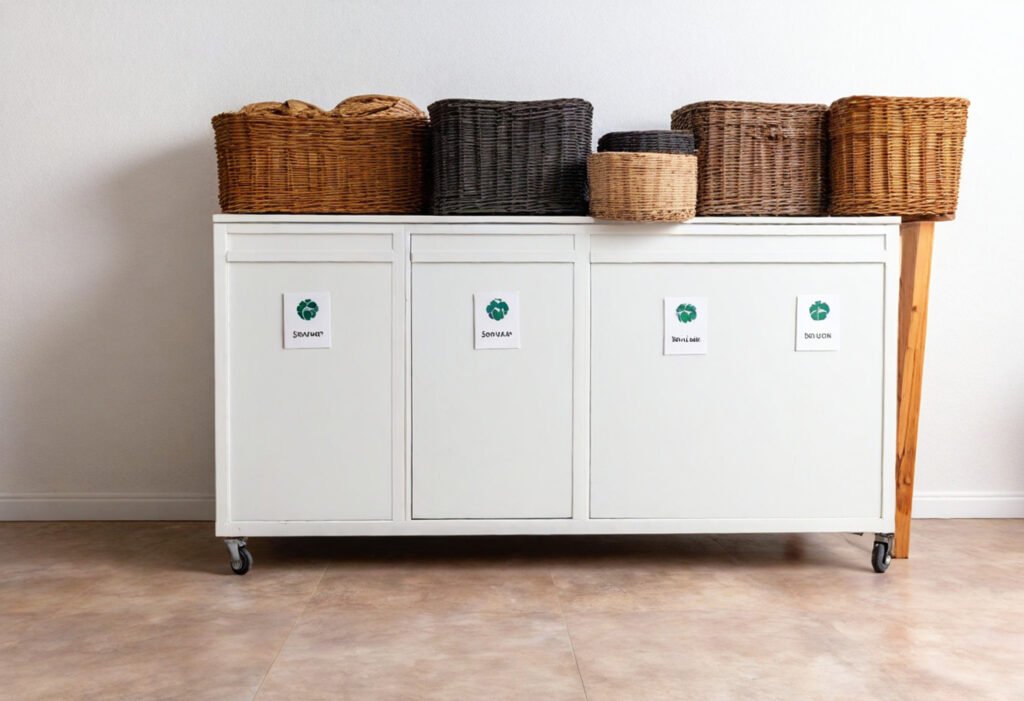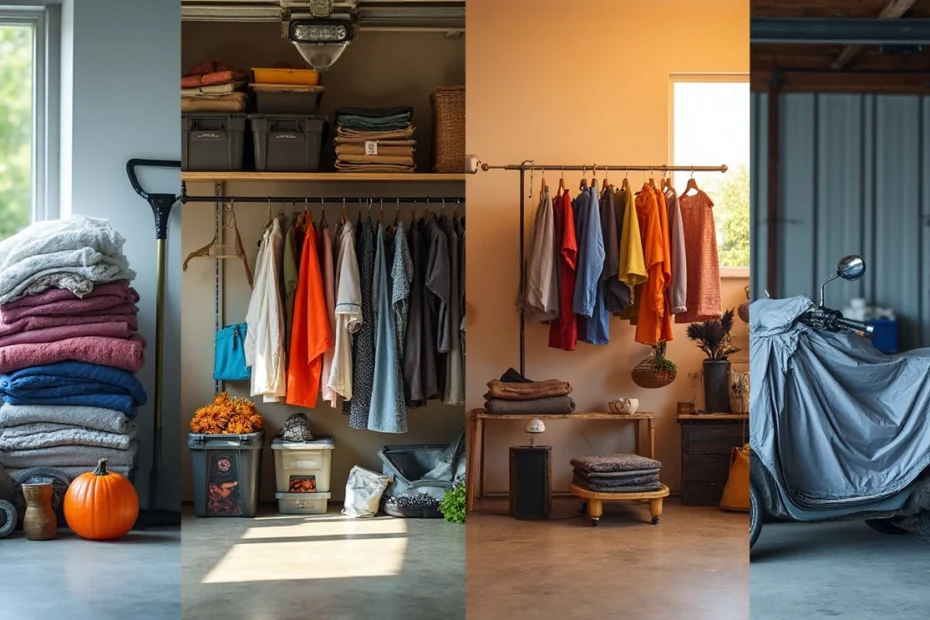Seasonal storage ideas look simple until you face a garage that’s become a dumping ground for holiday decorations and winter gear. Most of us have stared at piles of seasonal items and wondered about their storage until next year. The 90/90 rule suggests we should review our belongings based on their use in the last 90 days or the next 90 days.
Seasonal transitions create challenges for everyone, especially with wardrobe and décor management throughout the year. Storage ideas that work perfectly for winter coats might not suit summer swimwear. Solutions that keep holiday ornaments safe might fail to protect bulky patio furniture. On top of that, storing seasonal décor needs more planning than just boxing items and stacking them in corners. Those perfectly organized Pinterest photos often crumble in real life.
This piece uncovers what professional organizers rarely tell you about seasonal storage. You’ll learn about the mistakes, myths, and missed chances that keep homes cluttered despite your efforts. The hidden truths about spring storage traps and winter storage realities will change your approach to year-round organization.
The Spring Storage Trap: What You’re Doing Wrong
Spring cleaning creates a false sense of urgency. People rush to pack away winter items before the season truly ends. This premature move becomes the first trap many homeowners face with seasonal storage ideas. Damaged belongings and wasted space often result from these mistakes, issues that professional organizers rarely discuss.
Storing winter gear too early
Spring temperatures swing unpredictably, making early winter gear storage get pricey quickly. You might find yourself digging through packed boxes for that wool sweater or down jacket during a surprise cold snap, even in mid-April. Winter boots and outerwear need enough time to dry before storage. The moisture trapped from rushed packing creates perfect conditions for mold and mildew. The best approach is to wait until temperatures stay above 60°F consistently before packing heavy winter items.
Why labeling isn’t enough
“Label your boxes” seems like common storage advice, but this simplification leads to future problems. You’ll still need to open multiple containers to find specific items, even with basic labels that lack context or inventory lists. A storage system needs to work with:
- Categorization beyond seasons (occasion, family member, priority)
- Inventory sheets taped to containers
- Photos of container contents
- Digital tracking systems for larger collections
These methods eliminate the frustrating treasure hunt that simple labeling creates when you need that specific holiday centerpiece or snow boot.
The overlooked risk of moisture damage
Spring’s humidity presents a silent threat to stored items that most guides overlook. Winter clothes made of natural fibers face deterioration risks. Holiday decorations with paper elements and seasonal sports equipment can suffer damage in damp spring conditions. Cardboard boxes absorb moisture from concrete floors and humid air, despite their common recommendation. This dampness transfers directly to your belongings.
Plastic bins with silica gel packets work best to protect seasonal clothing from spring’s moisture changes. The sort of thing I love about seasonal decor storage ideas involves wrapping delicate items in acid-free tissue instead of newspaper, which can transfer ink and trap moisture. Cedar blocks serve double duty—they keep moths away and help control excess humidity in clothing storage.
Summer Storage Secrets Professionals Skip

Summer brings tough choices about storing off-season items. Storage professionals don’t tell you about the big differences between storage options that can protect your belongings during hot months.
The truth about air-cooled vs. climate-controlled units
Air-cooled and climate-controlled storage serve different purposes. Air-cooled units only manage temperature and keep interiors up to 20 degrees cooler than outside temperatures. But they don’t control humidity, a vital feature that protects sensitive items. Climate-controlled storage maintains stable temperatures (usually between 55°F and 85°F) and consistent humidity levels. This difference matters substantially during summer, especially with leather, wool, and delicate fabrics that can break down in humid conditions.
How to store seasonal clothing without fading or mildew
Storage experts often miss the key steps you need to prepare seasonal clothing. Clean all garments really well before you pack them – stains will set deeper if left untreated. Your knits and sweaters need folding rather than hanging to avoid stretching. Store them in breathable containers instead of airtight plastic.
To protect your clothes:
- Cedar blocks work better than mothballs for wool items
- Add moisture absorbers or silica gel packets in storage containers
- Plastic dry cleaning bags trap moisture and yellow your clothes – don’t use them
- Cotton garment bags protect delicate fabrics better than plastic covers
You need stable storage conditions with steady temperatures, so look for spaces that stay cool, dark, and dry all summer.
Why your garage isn’t a safe bet for summer gear
Your garage might seem convenient, but it’s the worst place for seasonal storage. It exposes your belongings to temperature extremes that damage electronics, photos, wine, and wooden furniture. The summer heat makes canned foods spoil fast and attracts pests to dry goods. On top of that, it causes wooden items to warp and crack from humidity changes, while cardboard boxes soak up moisture from concrete floors.
Important documents, photographs, clothing, and electronics need special care. These items can develop mold or mildew in changing conditions. The garage’s heat can separate paint and ruin wine, destroying expensive investments.
Fall Storage Mistakes That Cost You Space
“Before you organize, do a thorough edit.” — Apartment Therapy, Home design and organization publication
The falling autumn leaves remind us it’s time to tackle that dreaded task – putting away summer stuff while getting our fall decorations out. This seasonal switch often creates storage headaches that eat up our precious space.
The hidden bulk of outdoor equipment
Outdoor gear can be a real storage nightmare because of its weird shapes and sizes. Your camping stuff, lawn tools, and sports equipment will quickly fill up the garage without a good plan. Most storage guides tell you to just stack everything, but that’s not the best way to use your space. You’ll save more room by grouping your gear by type (camping, hiking, sports), which makes everything easy to find, too. If you’re into multiple outdoor activities, try using shared storage bins for items you use across different hobbies – this saves way more space than sorting everything by activity.
How to prep seasonal decor for long-term storage
Here’s something most professional organizers won’t tell you: always declutter before you store. Only keep the seasonal decorations that you’d rate “10 out of 10” for joy or use. After picking your favorites, make sure everything is clean and dry to avoid damage. The right protective materials make a big difference – bubble wrap or acid-free tissue paper work better than newspaper, which can leave ink stains and trap moisture. Clear plastic bins protect against dust and let you see what’s inside, so you won’t waste time digging through boxes.
Why vacuum-sealing isn’t always the best option
Vacuum sealing looks like a perfect space-saving solution, but it has some serious downsides. The heavy compression can ruin structured clothes like suits or delicate fabrics. The process itself takes a lot of work – all that pumping and pressing gets tiring quickly. If you don’t smooth clothes properly before sealing, you’ll end up with stubborn creases that won’t come out. Food storage gets tricky, too – vacuum sealing makes fruits and vegetables spoil faster by trapping ethylene gas that speeds up ripening. For dry goods, keeping moisture out matters more than removing air, so regular airtight containers often work just as well.
Winter Storage Realities No One Talks About

Winter months create the toughest conditions for stored items. This brings unique challenges that need specific solutions. Storage myths continue to circulate because we don’t realize how winter can affect our belongings.
The myth of ‘just cover it and store it’
A simple cover won’t protect your items during winter. Cheap tarps and plastic covers can cause more damage than they prevent. Low-quality tarps have rough surfaces that can harm paint and finishes as they move in winter winds. Plastic wraps make things worse by trapping moisture and creating perfect conditions for mold. Boats and outdoor equipment need proper breathable covers. Engines wrapped in plastic can collect moisture inside and face a higher risk of freeze damage.
How to protect furniture from cold damage
Cold storage takes a silent toll on furniture. Wood naturally holds moisture that expands in heat and contracts in cold. These temperature cycles can warp the wood over time. Cold temperatures can also make leather crack and damage upholstery. Your furniture needs:
- A good cleaning before storage
- Soft fabric covers instead of plastic wrap to avoid moisture
- Pallets to keep items off cold concrete floors
- Silica gel packets to control humidity
The truth about storing vehicles in freezing temperatures
You can’t just cover a vehicle and forget it in winter. A well-winterized vehicle should have clean oil since old oil contains corrosive contaminants. The gas tank should be full to prevent moisture buildup. The battery needs a full charge because partially charged batteries freeze more easily. Many people leave lights on in bilges to prevent freezing, but insurance companies prohibit this practice as it poses a fire risk.
Why heated units aren’t always worth the cost
Climate-controlled storage keeps temperatures between 55-78°F with 55% humidity. This premium service isn’t right for everything, though. Standard heated units without humidity control still expose items to moisture changes. Simple insulated storage works fine for seasonal items like holiday decorations and everyday clothing. Save climate-controlled units for items that really need stable temperatures – electronics, fine wooden furniture, leather goods, and valuable collections.
Conclusion
Seasonal storage is nowhere near as simple as most organizational guides make it seem. This piece reveals hidden truths about storage practices through all four seasons. Good storage needs thoughtful planning instead of quick fixes.
The 90/90 rule works as an excellent framework to decide what deserves storage space. Understanding each season’s unique challenges helps avoid making pricey mistakes. To name just one example, spring’s unpredictable weather means you should wait before packing away winter gear. Summer’s heat makes climate control vital for certain items.
Bulky outdoor equipment creates organizational challenges during fall. Winter, without doubt, brings the harshest conditions where simple covering solutions don’t give enough protection. So what works in one season rarely fits perfectly in another.
Professional organizers might suggest otherwise, but no single approach works for all seasonal storage needs. Success depends on your grasp of material properties, environmental factors, and practical access needs. The best storage systems adapt as your lifestyle changes.
Note that proper preparation matters more than perfect containers or labels when seasons change. Your items should be clean, completely dry, and stored based on material sensitivity rather than convenience. Take your time with the process—quick packing damages belongings and creates frustrating searches later.
Seasonal storage needs more planning than just boxing up off-season items. The extra effort pays off through better-preserved possessions and lower replacement costs. These storage insights will help you spend less time hunting for misplaced items and more time enjoying each season’s unique offerings.

